![]() 1st Battalion 22nd Infantry
1st Battalion 22nd Infantry ![]()
Oskaloosa M. Smith

Oskaloosa M. Smith
Photo is most likely of Smith when he
was regimental adjutant which required him to wear the plumed
helmet with breast cord
rather than the spiked helmet prescribed for company grade
infantry officers and the aiguillette for a regimental adjutant.
Identification courtesy of John P. Langellier, PhD.
Photo from the Army Center of Military History
Oskaloosa Minnewando Smith can
be considered the first Historian of the 22nd Infantry Regiment.
In 1895 the Military Service Institution of the United States
undertook a project that would compile a short history
of each of the Army's active units. The Military Service
Institution was an organization formed in 1878 of Active Duty
and Retired US Army officers, with the object of studying,
writing about and formally discussing military and
service related matters. The Institution can be said to be the
forerunner of today's Army Center of Military History,
though it did not actually evolve into that organization.
Oskaloosa Smith was chosen to write the entry for the 22nd
Infantry,
and his work is the earliest attempt at writing a history of the
Regiment.
Smith's work gave a short
history of the 22nd Infantry from its re-activation in 1866 to
the year 1890, and his narrative
concentrated mostly on the years the Regiment was actively
engaged against Sitting Bull and the Sioux. It was published in
the book
THE ARMY OF THE UNITED STATES
HISTORICAL SKETCHES OF STAFF AND LINE WITH PORTRAITS OF
GENERALS-IN-CHIEF
which was printed by MAYNARD, MERRILL, & CO., in 1896.
That short history of the
Regiment written by Smith was further used in both official
histories of the 22nd Infantry,
the first published in 1904 and the second published in 1922.
Smith had a long and colorful
career in the Army, serving for thirty-seven years, twenty-one of
those years
with the 22nd Infantry. He was a 2nd Lieutenant in the 31st
Infantry when that organization was merged with
the 22nd Infantry in 1869, and he would serve with the 22nd until
1890, when he was transferred to the
Subsistence Department and he became a Commissary of Subsistence.
His official history in the US
Army Registers, Annual Reports to the Secretary of War,
and the official histories of the 22nd Infantry is thus:
Enlisted
as a musician in Company I of the 13th Indiana Regiment of
Infantry on December 1, 1861,
and served with that unit until November 30, 1864, during which
time he attained the rank of
Quartermaster Sergeant.
He was
appointed a 1st Lieutenant and Adjutant of the 155th Indiana
Regiment of Infantry on April 25, 1865,
and served with that organization until mustered out on August 4,
1865.
He was
commissioned a 2nd Lieutenant in the 31st Infantry on June 18,
1867, accepting his commission
on August 6 of that year. At the same time he was given the
temporary rank of 1st Lieutenant of Volunteers.
Smith was officially transferred to the 22nd Infantry on May 15, 1869.
Acting Assistant Quartermaster at Camp Crow Creek Agency, Dakota Territory - Aug. 18, 1870 to May 5, 1871
He was promoted to 1st Lieutenant on June 28, 1876.
Smith was Regimental Quartermaster of the 22nd Infantry from June 25, 1879 to October 1, 1881. ¹
He was the Regimental Adjutant of the 22nd Infantry from October 1, 1881 to May 22, 1884.
He was
awarded a Brevet promotion to Captain on February 27, 1890, for
gallant services in action
with the 22nd Infantry against Indians at Spring Creek, Montana,
October 15 and 16, 1876.
On
August 14, 1890 he was offered the position of Captain,
Commissary of Subsistence, in the
Subsistence Department of the Army, which he accepted on August
30 of that year, leaving the
22nd Infantry after being with the Regiment for 21 years.
He was promoted to Major, Commissary of Subsistence, on November 15, 1897.
He was
given the temporary rank of Lieutenant Colonel, Commissary of
Subsistence,
from July 22, 1898 to March 2, 1899.
Smith retired as a Major on February 12, 1900.
He is listed in the Army Register of 1911 as having died in Lausanne, Switzerland on March 23, 1910.
The following illustrates Smith's military service from 1861 to 1890:
Smith, Oskaloosa M. (First Lieut. 22d Inf.). Born in Indianapolis, Indiana, Oct.11, 1845.
Retiring year 1911.
Appointed from Indiana—Civil life.
Actual Rank—
Musician Company" I" and Quartermaster Sergeant 13th Indiana Infantry Dec. 1, 1861, to Nov. 30, 1864;
1st Lieutenant and Adjutant 155th Indiana Infantry April 25, 1865;
honorably mustered out Aug. 4, 1865;
2d Lieutenant 31st Infantry June 18, 1867; accepted Aug. 6, 1867;
transferred to 22d Infantry May 15, 1869;
1st Lieutenant June 28, 1876.
Honorably mentioned—
Mentioned in the report of Colonel E. S. Otis, with reference to an engagement with the Indians at Clear Creek, Montana, Oct. 15, 1870.
Service—
Served in Western Virginia in Dec., 1861;
from Jan. to March, 1862, at Green Spring Run, Virginia;
in Shields' Division in the Shenandoah Valley during his Campaign of 1862;
at Harrison's Landing, Virginia, July,1862;
at Suffolk, Virginia, Aug. 1862, to May, 1863;
on Morris and Folly Islands, South Carolina, from Aug. 1863, to Feb. 1864;
at Jacksonville, Florida, from Feb. to May, 1864;
in the Army of the James May to Nov., 1864;
in Front at Petersburg and at Cold Harbor; served in Virginia and Delaware July to Aug., 1865;
at Fort Totten, Dakota Territory, Oct.,1867, to July, 1869;
served in the field many times during that period;
at Fort Sully, Dakota Territory July, 1869, to Aug., 1870;
at Crow Creek Agency, Dakota Territory, Aug., 1870, to May,1871;
at Fort Bully and on the expedition to the Yellowstone River May to Nov., 1871;
at Fort Randall, Dakota Territory, May, 1872, to June, 1874;
during part of that time served at Indian Agencies and on the Yellowstone expedition of 1873;
at Fort Wayne, Michigan, July to Sept., 1874;
at New Orleans, Louisiana, Sept., 1874, to May, 1875, during the White League difficulties;
at Fort Wayne, Michigan, May, 1875, to July, 1876;
in Montana during the Sioux Campaign July, 1876 to July, 1877;
at Chicago, Illinois, during the riots July, 1877 ;
at Fort Wayne, Michigan, Aug., 1877, to June, 1879;
at Fort McKavett, Texas, July to Nov., 1879;
at Fort Clark, Texas, Nov., 1879, to Nov., 1882;
at Santa Fe, New Mexico, Nov. 22, 1882, to Feb. 23, 1883;
at Fort Lewis, Colorado, March to Nov., 1883;
at Santa Fe, New Mexico, Nov. 5, 1883, to May 1, 1884;
on staff duty May 8, 1884, to May 22, 1888;
Fort Keogh, Montana Jan. '89, to ——.
Staff positions occupied—
Regimental Quartermaster. 22d Infantry Jan. 25, 1879, to Oct. 1, 1881;
Adjutanat 22d Infantry Oct. 1, 1881. to May 22, 1884;
Aide De Camp to Brigadier General Stanley May 8, 1884, to May 22, 1888;
inspector of rifle practice Deptartment of Texas Nov. 5, 1884, to Dec. 31, 1888;
Acting Engineer Officer Department of Texas March 29 to Oct. 4. 1886;
Acting Inspector General Department of Texas July 1 to Sept 6, 1886;
Acting Assistant Adjutant General Department of Texas Sept. 26, 1887, to Feb. 15, 1888,
and from April 2 to Oct. 15, 1888.
Battles, skirmishes, etc,—
Commanded the detachment of the 22d Infantry in the fight with the Brule Indians in their attack on Ponca Agency, Dakota Territory, June 14, 1872. ²

Oskalossa M. Smith, 155th Indiana Infantry, c. 1864.
Photo from the Indiana State Library website.
Below are two short biographies of Oskaloosa Smith
Oskaloosa
Minnewando Smith was born in October of 1845 and was a natural
for life in the army.
Enthralled by the stories told by his father of his exploits in
the Mexican War and instilled with a sense of duty
and service to country, it would have been more exceptional had
he not been an “army man”. While living in Madison
he joined the 13th Indiana Infantry, Company I as a musician. His
father, a printer by trade, and Oskaloosa’s younger brother,
Aurelius, also joined up. Aurelius was wounded at Chickamaugua
and returned home to join his father who had been released
from duty because of illness. The elder Smith soon died of
complications from the illness that struck him while in the
service
and the remaining Smith family members moved to Indianapolis.
Oskaloosa served in the 13th through October of 1863 during which
time he engaged in the campaign in West Virginia
and later in the Shanandoah Valley during which time he was
promoted to Quartermaster Sergeant in 1863 and engaged
in operations on Morris Island, S. C. (1863) and Seymour’s
Florida campaign (1864). By 1864 he attained the rank
of First Lieutenant and Adjutant in the 13th. He transferred in
the 155th Indiana Volunteers and engaged in the operations
of the Army of the Potomac from May to December in 1864. He was
Acting Assistant Adjutant-General, and Assistant
Inspector-General, district of Delaware and Eastern Shore of
Maryland, Middle Military Department, 1865. Oskaloosa
finished his Civil War stint in the military and was mustered
April 25,1865. In 1867 he transferred to the regular army
and was assigned to the 22nd U. S. Infantry. He was brevetted to
Captain for “gallantry against hostile Indians” at the
Battle of Spring Creek, Montana in 1876. He later wrote a
detailed account of his experiences in the Twenty Second.
He was, for some years stationed at various western forts,
including Fort Sully in the Dakotas and Fort Clark in Texas.
He later (1881-1884) served as Regimental Adjutant for the unit.
In 1885 he was assigned to Fort Sam Houston
in Texas. Here he was Judge Advocate and Aide-de-Camp to
Brigadier General David S. Stanley. He transferred
to the Commissary Department from which he retired as a
Lieutenant Colonel in 1900.
History Rescue Project
of the Jefferson County Public Library
420 W. Main St., Madison, IN 47250
Oskaloosa
Minnewando Smith was born 11 October 1845 in Indiana. He was the
son of Isaac Smith (b. 1818 in Vermont),
who was working as a printer and living with his family in the
city of Madison, Jefferson County, Indiana, at the time of the
1860 census. During the Civil War, Oskaloosa M. Smith entered the
army as a musician and later served as a Quartermaster
Sergeant. On 1 December 1861, from Ripley County, Indiana, he
mustered into the 13th Indiana Infantry, Company I. He
was commissioned as Adjutant for the 155th regiment and mustered
on 25 April 1865; at that time his residence was listed as
Madison, Indiana.
During the Indian War Era, he transferred to the Regular Army in
1867, assigned to the 22nd U.S. Infantry. He was brevetted
to Captain for “gallantry against hostile Indians” at
the Battle of Spring Creek, Montana, in 1876. He served as the
Regimental Adjutant for the unit from 1881–1884. In 1885 he
was assigned to Fort Sam Houston in Texas, where he served
as Judge Advocate and Aide-de-Camp to Brigadier General David S.
Stanley. In 1890 he transferred to the Commissary
Department where he retired as a Lieutenant Colonel in 1900.
The 1900 U.S. census lists Smith at the Army and Navy General
Hospital in Hot Springs, Arkansas. The record lists his
marital status as single, and indicates that his mother was born
in Kentucky. He died on 23 March 1910, according to the
memorial plaque at Christ Church Cathedral in Indianapolis.
From the Collection #
P 0471
OSKALOOSA M. SMITH PHOTOGRAPH ALBUM
CA. 1860S–CA. 1880S
Processed by
Barbara Quigley
11 November 2005
Manuscript and Visual Collections Department
William Henry Smith Memorial Library
Indiana Historical Society
450 West Ohio Street
Indianapolis, IN 46202-3269

The caption to the above photo reads:
"Oskaloosa
Minnewando Smith wears his dress uniform as a First Lieutenant of
the 22nd Infantry.
The spacing of the buttons on the coat and the rows of braid on
his belt identify him as a company-grade officer.
The aiguillette on his right shoulder indicates he is detailed as
an aide-de-camp to a general officer---
in this case to Brigadier General Stanley."
From: Fort Sam Houston Images of America Series by John Manguso Arcadia Publishing, 2012 ³
Oskaloosa M. Smith became a
member of the Sons of the American Revolution on January 19, 1892
in the District of Columbia Society. In 1902 he transferred to
the Indiana Society.
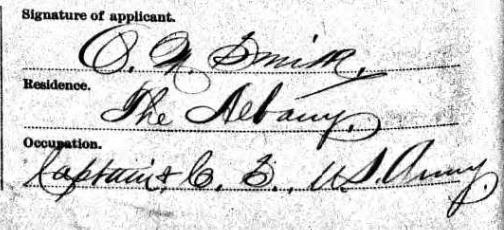
The signature of
Oskaloosa M. Smith on his application for membership in the Sons
of the American Revolution 1892.
He signed the application as a Captain, Commissary of
Subsistence.

Oskaloosa M. Smith's decorations
The following two photos
were taken at Fort Sam Houston, Texas, during the time when
Oskaloosa Smith was detailed as the Aide-de-camp to Brigadier
General David Stanley.
Stanley had been the Regimental Commander of the 22nd Infantry
1866-1884, and had relinquished
Command of the Regiment upon his promotion to Brigadier, when he
was appointed Commander
of the Department of Texas. The captions refer to Smith as a
"Captain", using his brevet rank.
 ³
³
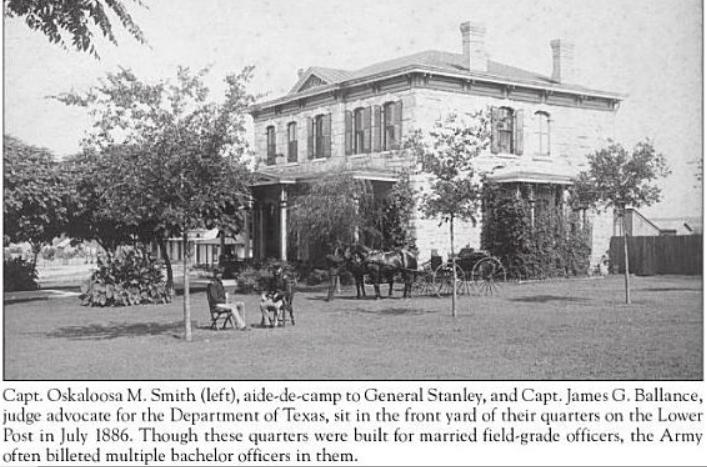 ³
³
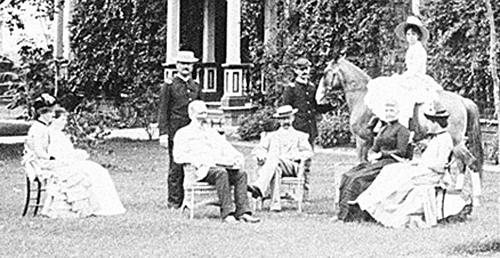
Seated, third from left, is BG David S.
Stanley, former Commander of the 22nd Infantry,
and, in this photo, Commander of the Department of Texas.
Standing behind him is his
Aide, 1LT Oskaloosa Smith. In front of Stanley's home, the post
commander's house,
Ft. Sam Houston, TX. Photo taken 1886.
Photo from the website: Anna Stanley An American Impressionist
Birth: Oct. 11, 1845
Indianapolis
Marion County
Indiana, USA
Death: Mar. 23, 1910
Indianapolis
Marion County
Indiana, USA
(Note: The Official US Army
Register for 1910 lists Major O. Smith died
March 23, 1910 at Lausanne, Switzerland)
Burial:
Crown Hill Cemetery
Indianapolis
Marion County
Indiana, USA
Plot: Section 38, Lot 193

Cemetery monument for Oskaloosa Smith
Photo by Rick France from the Find A Grave website
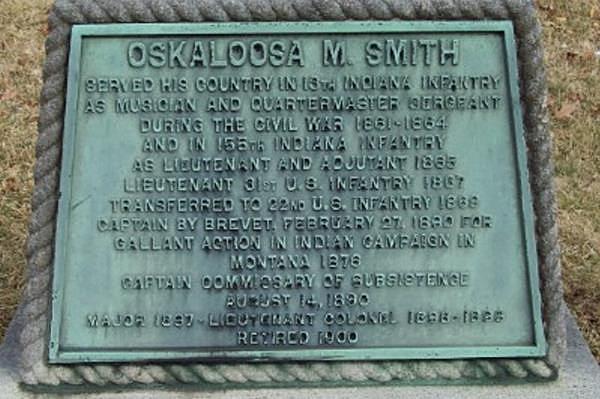
Plaque on the cemetery monument for Oskaloosa Smith
Photo by Rick France from the Find A Grave website
THE HISTORIC FISHING ROD OF
OSKALOOSA M. SMITH
By Dan Basore
While packing my van to travel from my Chicagoland home to
Daytona Beach, Florida for the March 2000 Florida International
Fishing Tackle Show the telephone rang. As a serious collector of
old fishing items since 1957, historian, exhibitor in museums,
sports shows and writer about fishing history this wasn’t
unusual as many contact us for identification, values and selling
old tackle.
An old friend from my home town Indianapolis, was calling to
share information from a lady who conducted estate sales. She
found
in an attic a fishing rod from Orvis in a tapered wood box.
Taking it around to tackle shops, antique dealers and even an
Orvis “expert”,
she was told it was a fantasy piece as Orvis only made split
bamboo rods.
Since my trip to Florida was taking me through Indy the next day
we made plans and met. Immediately confirming her impression
even though never seeing or hearing of such a rod, we agreed on a
price and proceeded to the show in Florida with it.
As we shared this find with friends and collectors, there was a
man they called “Whitey” who had worked for Orvis for
over 30 years.
He verified that it was genuine and made of lance and lemon wood.
Orvis began making fly rods and incorporated as the C.F. Orvis
Company in 1856. He open his store that year with a small stone
building
next to his brother Franklin’s hotel in Manchester, Vermont
and the family businesses prospered with their promotion of
resort vacation travel.
By 1860 the family businesses grew with trains bringing tourists
from New York and the North east. Their well made wood rods and
flies
brought added sales by mail. As the resort area began it’s
season in April 1861 the Civil War began putting a damper on
their businesses.
Even though others were making rods of split bamboo it
wasn’t until 1876 that Orvis began making split bamboo fly
rods
while still making some of lancewood. Most still used small
baitcasting reels on their flyrods.
In 1874 Orvis obtained a patent on a new ventilated, narrow spool
design of fly reels in various sizes that revolutionized the
industry.
Many metals were used in making these reels including brass,
aluminum and even a few gold presentation models.
O.M. Smith 22nd U.S. Infantry
As a specialist in fishing history the preceding was my focus
after acquiring this rare rod. A genealogist that did background
research
for me on early fishing tackle makers took an interest in this
fifteen years ago.
He presented his notes with the owners full name, Oskaloosa
Minnewande Smith, birth and death dates, basic information.
But he assumed that Smith was buried where he died in Lausanne,
Switzerland.
Recent interest prodded an unsuccessful search for these notes. A
Google search was much more productive leading me to this
wonderful site and much more information than we had before.
I’m looking forward to visiting his grave and any other
information
that you may obtain and provide. It’s inspiring to read the
history of the 22nd Infantry as an Army veteran with a brother
who served
in Vietnam with the Big Red One whose museum is near my home.
Rumors of the family owning a tin type photo of O.M.Smith being
presented this rod were received but never produced results.
Someone also said there was an article we haven’t found,
proclaiming that Smith was the oldest Civil War veteran from
Howe High School in Indianapolis.
My hope is that this will lead to more information on this great
soldier.
Dan Basore - December 28, 2016
Dan Basore is a fishing historian and
steward of the history of the sport. In his efforts to preserve
fishing history, Basore is always on the lookout for information
about early lure makers, old lures, pre-level wind reels,
manufacturers catalogs, tournament casting items and the like. If
you possess information or materials that can help
email ollures@aol.com or call 1-630-393-FISH (3474) or
1-800-FISH-LAKE that’s 1-800-347-4525 or write Dan Basore,
3S375 Herrick Rd., Warrenville, IL 60555.
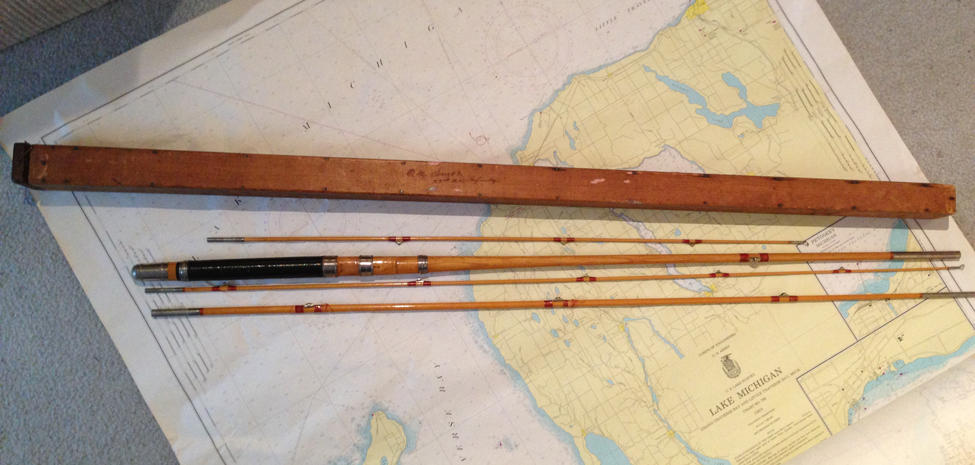
Orvis rod belonging to Oskaloosa M. Smith with its tapered wooden case
Photo by Dan Basore

Orvis rod belonging to Oskaloosa M. Smith with its tapered wooden case
Photo by Dan Basore
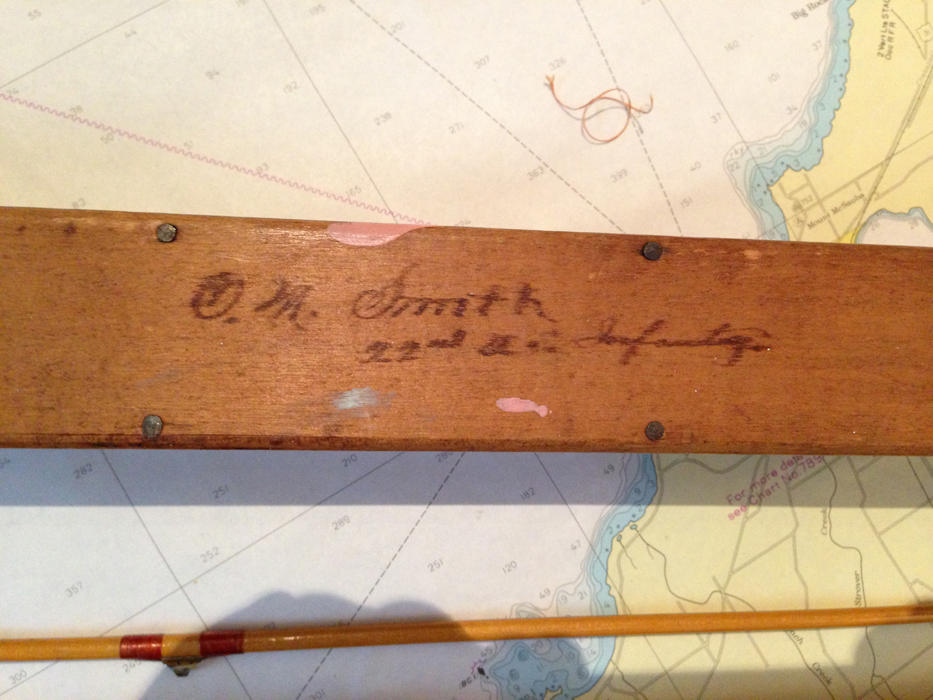
Close-up of the wooden case showing the inscription of:
O. M. Smith
22nd U.S. Infantry
Photo by Dan Basore
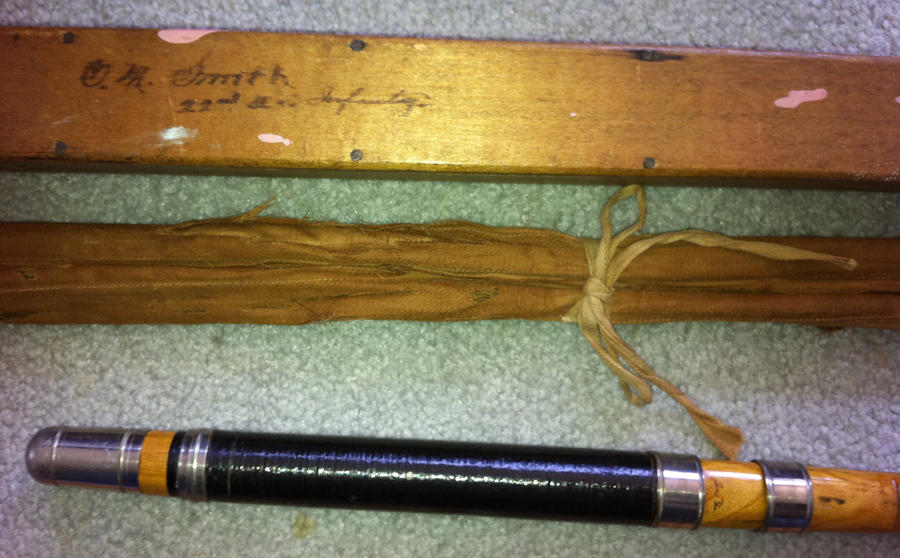
Close-up showing the case, rod and cloth protective cover for the rod sections
Photo by Dan Basore
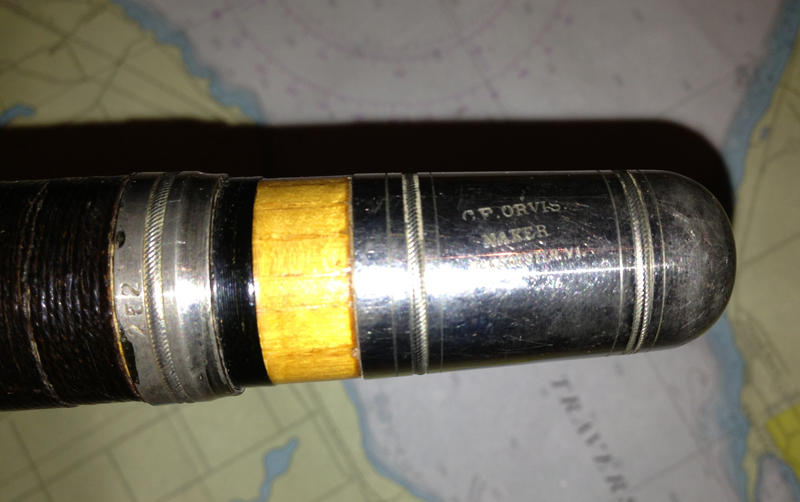
Close-up of the rod handle showing the manufacturer's name of C.F. Orvis
Photo by Dan Basore
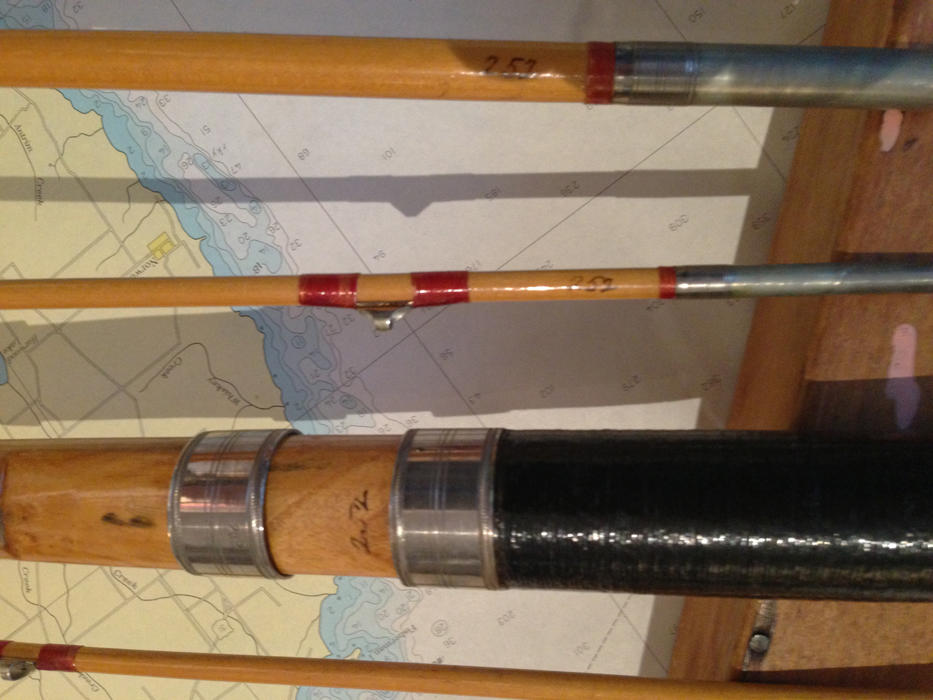
Close-up of rod sections
Photo by Dan Basore
¹ From the Regimental History 1904. The
beginning date differs from that in Powell's book, which is
listed as January 25, 1879.----------------
² Powell's Records of Living Officers of the United States Army
by William H. Powell Major 22d Infantry, U.S.A. Philadelphia:----------------
L.R. Hamersly & Co. 1890 Page 555-------------------------------------------------------------------------------------------
------³ Fort Sam Houston Images of America Series by
John Manguso Arcadia Publishing, 2012, ISBN 0738596167,
9780738596167---------------
Home | Photos | Battles & History | Current |
Rosters & Reports | Medal of Honor | Killed
in Action |
Personnel Locator | Commanders | Station
List | Campaigns |
Honors | Insignia & Memorabilia | 4-42
Artillery | Taps |
What's New | Editorial | Links |